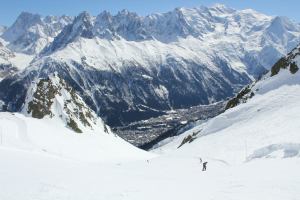Where is the wood energy?
I’ve been delayed writing my blog on spring energy: partly because I have been away but partly because it hasn’t felt very much like spring. Apparently March has been colder in the UK than December, January and February and, in England, the coldest March on record. Last week I was away in the Alps in Chamonix where the weather was snowy and misty most of the time. This was good for the snow but not for seeing the mountains or getting some sun.
So what about the Chinese view of spring and the moving out from the Winter Yin energy to the Yang? Where is this Yang? Well, we can see it in the longer, lighter days, the buds of leaves on trees and plants sprouting from the ground. Life is emerging from the earth. Birds are busy making nests and, on the rare sunny days, people are out smiling and interacting more with each other.
Who said wood energy is predictable or there is a smooth transition from Yin towards Yang? For me, one of the main gifts of Chinese medicine is its way of connecting the body to nature and seeing how we are influenced by our environment. Spring is different every year. Sometimes it comes earlier, sometimes later. Sometimes it shows its face, only to disappear again. How is Spring being affected by climate change? People have noted that there is less snow, 40% less in areas under 1000 m, that the glaciers are declining (the Mer de glace has lost 65 cm in depth) , that the average temperature is 0.75 c higher http://www.guardian.co.uk/environment/2013/mar/31/alps-skiing-climate-change. The world is an ever changing place. It also depends where you are. I was acutely aware of this in the mountains. The northern sides of the mountains stayed firm all day long but on the southern sides, snow was slushy by the end of the day.

How do we support this Spring energy in our body? Mostly by moving. And by understanding that our body, like the world, is ever changing. It is different from year to year as well as from season to season. Staying connected with nature helps us remember that we too have our cycles. Spring is the energy of new birth: this can be birth in its literal sense of babies, but can also be new projects, creative enterprises and ideas.
The meridians of spring, of wood, are Liver and Gall Bladder. Gall Bladder is the main meridian of the side of the body, running from the outer eye, through the side of the neck, around the shoulder and down the side of the torso into the side of the leg. When people don’t move and sit at desks a lot of the time, then they tend to get congestion in their hips and shoulders. GB21 is a point in top of the trapezius muscle on the shoulder which is often gets tight. Shiatsu can help free up some of this tightness which can build up through a more sedentary life style.
So move out into nature, as spring calls us to. Enjoy the ever changing circle of life.


yes I was sad about this as I really enjoyed it. i have just been given refererred to this book by a tutor and thought you might find it interesting as well What-forgot-tell-Surgeons-ebook as i haven’t got a kindle at the moment but it looks like ‘the body electric’ meets ‘the endless web’ at a glance, it might be worth reading if you have a kindle. thanks for your help.
thanks, I am going to study accupuncture beginning this weekend for 3 years. I loved the shiatsu course, but i did not complete my diploma. I felt that I needed to do the in depth work that the accupuncture course provided. I still practice shiatsu on guinea pigs, and am a very willing fan of shiatsu! I would like to continue study, but I find that it all inter-relates so I think I will have to be satisfied with needling people professionally, and giving the much loved ‘cwtch’ approach that shiatsu allows privately. I will certainly get back to you in future! Do you do courses for people who aren’t fully qualified?
Shame you didn’t feel that the shiatsu course didn’t offer enough in depth work. It should!!! That’s partly why I wrote the article!
hi! I just wanted to say that apart from enjoying this post on spring, which is very late, and still trying to ‘spring’, I also enjoyed your article in Shiatsu Society Journal which I felt was very valid, and has given me much more in depth reading material to go out and reference. I particularly valued the extra information on the extra ordinary vessels and 6 super meridians which although I have come accross them in tai chi and chi gung practice have not had the oppertunity to look at them in a shiatsu context before. I also felt that it is particularly important to look at the the cross referencing between western and eastern/ oriental medicine to find areas of common ground, because as you point out the holistic and age old form of the TCM meridian system is extremently widely used, tried and tested.The way you have presented the information about them will make it very easy to do further research and study in relation to understanding the body and embriology. Thanks for this great article and the experience behind it that made it possible. I wish I could have had the oppertunity to study under Sonja Morceau as I understand from my Shiatsu practitioner that this school was an excellent place of teaching.
thank you for this feedback and also your feedback on my article in the Shiatsu Society. Good luck with your continuing study. And do let me know if you have any other questions. Suzanne